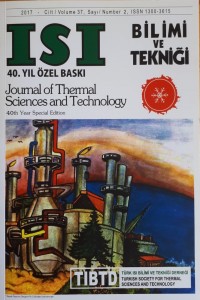INVESTIGATION OF AN SI-CAI ENGINE FUELLED WITH METHANE-HYDROGEN MIXTURES FOR DIFFERENT EXHAUST VALVE LIFTS
Öz
In this study, a spark-assisted controlled auto-ignition (SI-CAI) engine with different Methane-Hydrogen blends was numerically and experimentally investigated under different excess air ratio and valve lift value conditions. Experimental results were used to validate the numerical study. GT-Power simulation tool was used for the numerical studies. The valve lifts were created ranging from 3.0 to 5.0 mm with 0.5 increments. The excess air ratio () values were considered as 1.0, 1.1, 1.2, 1.3 and 1.4. Besides, Methane-Hydrogen blends were constituted as 100% Methane (100M), 90% Methane-10% Hydrogen (90M10H), 80% Methane-20% Hydrogen (80M20H) and 70% Methane-30% Hydrogen (70M30H) by volume. Results revealed that the peak pressure values increase when the valve lift increases. The pressure and temperature values tend to reduce with the increasing of values. Increasing the volume fraction of Hydrogen in Methane–Hydrogen blend contributes to pressure development earlier. As a conclusion increasing of the volume fraction of Hydrogen in the Methane-Hydrogen blend causes a reduction in the indicated thermal efficiency and mean effective pressure, and a lower specific fuel consumption.
Anahtar Kelimeler
Kaynakça
- Bai Y, Wang Z, Wang J., 2010, Part-load characteristics of direct injection spark ignition engine using exhaust gas trap. Applied Energy, 87, 2640-46.
- Cao L., Zhao H., Jiang X. and Kalian N., 2005, Numerical Study of Effects of Fuel Injection Timings on CAI/HCCI Combustion in a Four-Stroke GDI Engine, SAE International, 2005-01-0144.
- Chen R, Milovanovic N, Turner J, Blundell D., 2003, The thermal effect of internal exhaust gas recirculation on controlled auto ignition. SAE paper 2003-01-0751.
- Chen T, Xie H, Li L, Zhang L, Wang X, Zhao H., 2014, Methods to achieve HCCI/CAI combustion at idle operation in 4VVAS gasoline engine. Applied Energy, 116, 41-51.
- Cinar C, Uyumaz A, Solmaz H, Topgul T., 2015, Effects of valve lift on the combustion and emissions of a HCCI gasoline engine. Energy Conversion and Management, 94, 159-68.
- Ebrahimi R, Desmet B., 2010, An experimental investigation on engine speed and cyclic dispersion in an HCCI engine. Fuel, 89, 2149-56.
- Fjallman J., 2014, GT-Power Report, KTH Mechanics, SE-100-44 Stockholm, Sweden, https://www.diva-portal.org/smash/get/diva2:624472/FULLTEXT01.pdf Guo H, S.Neill W., 2013, The effect of Hydrogen addition on combustion and emission characteristics of an n-heptane fuelled HCCI engine. Int J Hydrogen Energy, 38, 11429-37.
- Heywood, J. B.(1988). Internal Combustion Engine Fundamentals. McGraw-Hill, Newyork, USA.
- Hunicz J, Kordos P., 2011, An experimental study of fuel injection strategies in CAI gasoline engine. Experimental Thermal and Fluid Science, 35, 243-52.
- Kalian N, Zhao H, Qiao J., 2008, Investigation of transition between spark ignition and controlled auto-ignition combustion in a V6 direct-injection engine with cam profile switching. Proc. IMechE, Part D: Journal of Automobile Engineering, 222, 1911-26.
- Karim G.A., Wierzba I. and Al-Alousi Y., 1996, Methane-Hydrogen mixtures as fuels. Int J of Hydrogen Energy, 21(7), 625-31.
- Knop V, Francqueville L, Duffour F, Vangraefschèpe, F., 2009, Influence of the valve-lift strategy in a CAI engine using exhaust gas re-breathing -Part 2: Optical Diagnostics and 3D CFD Results. SAE Int. J. Engines, 2(1), 271-88.
- Lee C.H, Lee K.H., 2007, An experimental study of the combustion characteristics in SCCI and CAI based on direct-injection gasoline engine. Experimental Thermal and Fluid Science, 31, 1121-32.
- Lee K, Kim Y, Byun C, Lee J., 2013, Feasibility of compression ignition for Hydrogen fueled engine with neat Hydrogen-air pre-mixture by using high compression. Int J Hydrogen Energy, 38, 255-64.
- Mahrous A.F.M, Potrzebowski A, Wyszynski M.L, Xu H.M, Tsolakis A, Luszcz P., 2009, A modeling study into effects of variable valve timing on the gas exchange process and performance of a 4-valve DI homogeneous charge compression ignition (HCCI) engine. Energy Conversion and Management, 50, 393-98.
- Moreno1 F., Muñoz M., Magén O., Monné C., Arroyo J., 2010, Modifications of a spark ignition engine to operate with Hydrogen and Methane blends, International Conference on Renewable Energies and Power Quality (ICREPQ’10) Granada (Spain), 23th to 25th March.
- Naeve N, He YT, Deng J., 2011, Waste coke oven gas used as a potential fuel for engines, SAE Technical Paper; SAE 2011-01-0920.
- Stone R., 1999, Introduction to Internal Combustion Engines, Third Edition. Society of Automotive Engineers Inc., Warrendale, 641 pp.
- Syed Y., Venkateswarlu K. and Khan N., 2012, Effect of Ignition Timing and Equivalence Ratio on the Performance of an Engine Running at Various Speeds Fuelled with Gasoline and Natural Gas, International Journal of Advanced Science and Technology Vol. 43, June.
- Yao M, Zheng Z, Liu H., 2009, Progress and recent trends in homogeneous charge compression. Progress in Energy and Combustion Science, 35, 398-437.
- Yeom K, Jang J, Bae C., 2007, Homogeneous charge compression ignition of LPG and gasoline using variable valve timing in an engine. Fuel, 86, 494-03.
- Yildiz M., Akansu S.O., Albayrak Çeper B., 2015, Computational Study of EGR and Excess Air Ratio Effects on a Methane Fueled CAI Engine, International Journal of Automotive Engineering and Technologies, vol.4, 152-161.
- Zhang C, Wu H., 2012, The simulation based on Chemkin for homogeneous charge compression ignition combustion with on-board fuel reformation in the chamber. Int J Hydrogen Energy, 37, 4467-75.
- Zhang C.,Pan J.,Tong J.,Li J., 2011, Effects of Intake Temperature and Excessive Air Coefficient on Combustion Characteristics and Emissions of HCCI Combustion, Procedia Environmental Sciences, 11:1119-1127.
Ayrıntılar
| Birincil Dil | İngilizce |
|---|---|
| Konular | Makine Mühendisliği |
| Bölüm | Araştırma Makalesi |
| Yazarlar | |
| Yayımlanma Tarihi | 31 Ekim 2017 |
| Yayımlandığı Sayı | Yıl 2017 Cilt: 37 Sayı: 2 |


